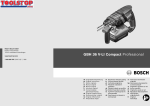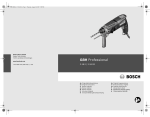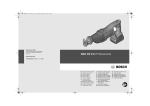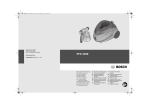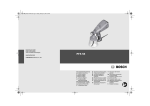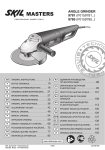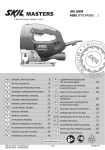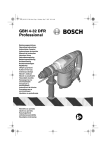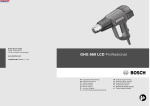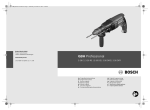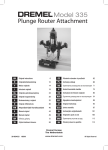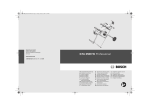Download Bosch GBH Professional Operating instructions
Transcript
Robert Bosch GmbH Power Tools Division 70745 Leinfelden-Echterdingen www.bosch-pt.com GBH Professional 1 619 929 740 (2007.07) O / 283 24 VFR | 24 VRE de en fr es pt it nl Originalbetriebsanleitung Original instructions Notice originale Manual original Manual original Istruzioni originali Oorspronkelijke gebruiksaanwijzing da Original brugsanvisning sv Bruksanvisning i original no Original driftsinstruks fi Alkuperäiset ohjeet el tr pl cs sk hu ru uk Πρωτότυπο οδηγιών χρήσης Orijinal işletme talimat Instrukcją oryginalną Původním návodem k používání Pôvodný návod na použitie Eredeti használati utasítás Одлинник руководства по эксплуатации Оригінальна інструкція з експлуатації ro Instrucţiuni de folosire originale bg Оригинално ръководство за експлоатация sr Originalno uputstvo za rad sl Izvirna navodila hr Originalne upute za rad et Algupärane kasutusjuhend lv Instrukcijām oriģinālvalodā lt Originali instrukcija 3| A B 15 11 14 C x 13 12 5 D 1 4 E 17 18 3 16 GBH 24 VFR 1 619 929 740 | (24.7.07) GBH 24 VRE Bosch Power Tools 4| F G 3 H I 21 20 RELEASE, AUF 19 GRIP, ZU 22 GBH 24 VFR 1 619 929 740 | (24.7.07) Bosch Power Tools 5| 6 5 1 4 3 7 8 2 13 12 9 10 11 GBH 24 VFR Professional 1 619 929 740 | (24.7.07) Bosch Power Tools English | 17 General Power Tool Safety Warnings en Read all safety warnings and all instructions. Failure to follow the warnings and instructions may result in electric shock, fire and/or serious injury. Save all warnings and instructions for future reference. The term “power tool” in the warnings refers to your mains-operated (corded) power tool or battery-operated (cordless) power tool. WARNING 1) Work area safety a) Keep work area clean and well lit. Cluttered or dark areas invite accidents. b) Do not operate power tools in explosive atmospheres, such as in the presence of flammable liquids, gases or dust. Power tools create sparks which may ignite the dust or fumes. c) Keep children and bystanders away while operating a power tool. Distractions can cause you to lose control. 2) Electrical safety a) Power tool plugs must match the outlet. Never modify the plug in any way. Do not use any adapter plugs with earthed (grounded) power tools. Unmodified plugs and matching outlets will reduce risk of electric shock. b) Avoid body contact with earthed or grounded surfaces, such as pipes, radiators, ranges and refrigerators. There is an increased risk of electric shock if your body is earthed or grounded. c) Do not expose power tools to rain or wet conditions. Water entering a power tool will increase the risk of electric shock. d) Do not abuse the cord. Never use the cord for carrying, pulling or unplugging the power tool. Keep cord away from heat, oil, sharp edges and moving parts. Damaged or entangled cords increase the risk of electric shock. e) When operating a power tool outdoors, use an extension cord suitable for outdoor use. Use of a cord suitable for outdoor use reduces the risk of electric shock. Bosch Power Tools f) If operating a power tool in a damp location is unavoidable, use a residual current device (RCD) protected supply. Use of an RCD reduces the risk of electric shock. 3) Personal safety a) Stay alert, watch what you are doing and use common sense when operating a power tool. Do not use a power tool while you are tired or under the influence of drugs, alcohol or medication. A moment of inattention while operating power tools may result in serious personal injury. b) Use personal protective equipment. Always wear eye protection. Protective equipment such as dust mask, non-skid safety shoes, hard hat, or hearing protection used for appropriate conditions will reduce personal injuries. c) Prevent unintentional starting. Ensure the switch is in the off-position before connecting to power source and/or battery pack, picking up or carrying the tool. Carrying power tools with your finger on the switch or energising power tools that have the switch on invites accidents. d) Remove any adjusting key or wrench before turning the power tool on. A wrench or a key left attached to a rotating part of the power tool may result in personal injury. e) Do not overreach. Keep proper footing and balance at all times. This enables better control of the power tool in unexpected situations. f) Dress properly. Do not wear loose clothing or jewellery. Keep your hair, clothing and gloves away from moving parts. Loose clothes, jewellery or long hair can be caught in moving parts. g) If devices are provided for the connection of dust extraction and collection facilities, ensure these are connected and properly used. Use of dust collection can reduce dust-related hazards. 1 619 929 740 | (24.7.07) 18 | English 4) Power tool use and care a) Do not force the power tool. Use the correct power tool for your application. The correct power tool will do the job better and safer at the rate for which it was designed. b) Do not use the power tool if the switch does not turn it on and off. Any power tool that cannot be controlled with the switch is dangerous and must be repaired. c) Disconnect the plug from the power source and/or the battery pack from the power tool before making any adjustments, changing accessories, or storing power tools. Such preventive safety measures reduce the risk of starting the power tool accidentally. d) Store idle power tools out of the reach of children and do not allow persons unfamiliar with the power tool or these instructions to operate the power tool. Power tools are dangerous in the hands of untrained users. e) Maintain power tools. Check for misalignment or binding of moving parts, breakage of parts and any other condition that may affect the power tool’s operation. If damaged, have the power tool repaired before use. Many accidents are caused by poorly maintained power tools. f) Keep cutting tools sharp and clean. Properly maintained cutting tools with sharp cutting edges are less likely to bind and are easier to control. g) Use the power tool, accessories and tool bits etc. in accordance with these instructions, taking into account the working conditions and the work to be performed. Use of the power tool for operations different from those intended could result in a hazardous situation. 5) Battery tool use and care a) Recharge only with the charger specified by the manufacturer. A charger that is suitable for one type of battery pack may create a risk of fire when used with another battery pack. 1 619 929 740 | (24.7.07) b) Use power tools only with specifically designated battery packs. Use of any other battery packs may create a risk of injury and fire. c) When battery pack is not in use, keep it away from other metal objects, like paper clips, coins, keys, nails, screws or other small metal objects, that can make a connection from one terminal to another. Shorting the battery terminals together may cause burns or a fire. d) Under abusive conditions, liquid may be ejected from the battery; avoid contact. If contact accidentally occurs, flush with water. If liquid contacts eyes, additionally seek medical help. Liquid ejected from the battery may cause irritation or burns. 6) Service a) Have your power tool serviced by a qualified repair person using only identical replacement parts. This will ensure that the safety of the power tool is maintained. Machine-specific Safety Warnings f Wear hearing protection. Exposure to noise can cause hearing loss. f Always use the auxiliary handle supplied with the machine. Loss of control can cause personal injury. f Use appropriate detectors to determine if utility lines are hidden in the work area or call the local utility company for assistance. Contact with electric lines can lead to fire and electric shock. Damaging a gas line can lead to explosion. Penetrating a water line causes property damage or may cause an electric shock. f Hold the machine only by the insulated gripping surfaces, when performing an operation where the cutting tool may run into hidden wiring. Contact with a “live” wire will make exposed metal parts of the tool “live” and shock the operator. Bosch Power Tools English | 19 f When working with the machine, always hold it firmly with both hands and provide for a secure stance. The power tool is guided more secure with both hands. f Secure the workpiece. A workpiece clamped with clamping devices or in a vice is held more secure than by hand. f Do not work materials containing asbestos. Asbestos is considered carcinogenic. f Take protective measures when dust can develop during working that is harmful to one’s health, combustible or explosive. Example: Some dusts are regarded as carcinogenic. Wear a dust mask and work with dust/chip extraction when connectable. f Keep your workplace clean. Blends of materials are particularly dangerous. Dust from light alloys can burn or explode. f Always wait until the machine has come to a complete stop before placing it down. The tool insert can jam and lead to loss of control over the power tool. f Avoid unintentional switching on. Ensure the On/Off switch is in the off position before inserting battery pack. Carrying the power tool with your finger on the On/Off switch or inserting the battery pack into power tools that have the switch on invites accidents. f Do not open the battery. Danger of shortcircuiting. Protect the battery against heat, e. g., also against continuous sun irradiation and fire. There is danger of explosion. Functional Description Read all safety warnings and all instructions. Failure to follow the warnings and instructions may result in electric shock, fire and/or serious injury. Intended Use The machine is intended for hammer drilling in concrete, brick and stone. It is also suitable for drilling without impact in wood, metal, ceramic and plastic. Machines with electronic control and right/left rotation are also suitable for screwdriving and thread cutting. Product Features The numbering of the product features refers to the illustration of the machine on the graphics page. 1 SDS-plus tool holder 2 Dust protection cap 3 Locking sleeve 4 Lock ring of the tool holder (GBH 24 VFR) 5 Button for depth stop adjustment 6 Selector switch for drilling/hammer drilling 7 Rotational direction switch 8 On/Off switch 9 Button for charge-control indicator 10 Battery charge-control indicator 11 Battery* 12 Auxiliary handle 13 Depth stop 14 Battery release button* 15 Protection cap for battery 16 Securing screw for key type drill chuck* 17 Key type drill chuck* 18 SDS-plus adapter shank for drill chuck* 19 Quick change keyless chuck (GBH 24 VFR) 20 Front sleeve of the quick change keyless chuck (GBH 24 VFR) 21 Retaining ring of the quick change keyless chuck (GBH 24 VFR) 22 Universal bit holder with SDS-plus shank* *The accessories illustrated or described are not included as standard delivery. While reading the operating instructions, unfold the graphics page for the machine and leave it open. Bosch Power Tools 1 619 929 740 | (24.7.07) 20 | English Technical Data Rotary Hammer GBH 24 VFR Professional GBH 24 VFR Professional GBH 24 VRE Professional GBH 24 VRE Professional 0 611 260 5.. 0 611 261 7.. 0 611 261 5.. 0 611 260 7.. Rated voltage V= 24 24 24 24 Rated power input W 350 350 350 350 Rated speed rpm 0–1000 0–1000 0–1000 0–1000 Impact rate bpm 0–4400 0–4400 0–4400 0–4400 Article number J 1.3 1.3 1.3 1.3 SDS-plus SDS-plus SDS-plus SDS-plus mm mm mm 20 10 20 20 10 20 20 10 20 20 10 20 kg 3.5 4.2 3.5 4.2 Impact energy per stroke Tool holder Max. drilling dia. – Concrete (with twist drill) – Steel – Wood Weight according to EPTA-Procedure 01/2003 Please observe the article number on the type plate of your machine. The trade names of the individual machines may vary. Noise/Vibration Information Measured values determined according to EN 60745. Typically the A-weighted noise levels of the product are: Sound pressure level 91 dB(A); Sound power level 102 dB(A). Uncertainty K =3 dB. Wear hearing protection! Vibration total values (triax vector sum) determined according to EN 60745: Hammer drilling into concrete: Vibration emission value ah =12 m/s2, Uncertainty K=1.5 m/s2. The vibration emission level given in this information sheet has been measured in accordance with a standardised test given in EN 60745 and may be used to compare one tool with another. It may be used for a preliminary assessment of exposure. The declared vibration emission level represents the main applications of the tool. However if the tool is used for different applications, with different accessories or poorly maintained, the vibration emission may differ. This may significantly increase the exposure level over the total working period. 1 619 929 740 | (24.7.07) An estimation of the level of exposure to vibration should also take into account the times when the tool is switched off or when it is running but not actually doing the job. This may significantly reduce the exposure level over the total working period. Identify additional safety measures to protect the operator from the effects of vibration such as: maintain the tool and the accessories, keep the hands warm, organisation of work patterns. Declaration of Conformity We declare under our sole responsibility that the product described under “Technical Data” is in conformity with the following standards or standardization documents: EN 60745 according to the provisions of the directives 2004/108/EC, 98/37/EC (until Dec. 28, 2009), 2006/42/EC (from Dec. 29, 2009 on). Technical file at: Robert Bosch GmbH, PT/ESC, D-70745 Leinfelden-Echterdingen Bosch Power Tools English | 21 Dr. Egbert Schneider Senior Vice President Engineering Dr. Eckerhard Strötgen Head of Product Certification 0 – 10 % 10 – 20 % 20 – 40 % 40 – 60 % 29.06.2007, Robert Bosch GmbH, Power Tools Division D-70745 Leinfelden-Echterdingen 60 – 80 % 80 – 100 % Assembly f Before any work on the machine (e. g., maintenance, tool change, etc.) as well as during transport and storage, set the rotational direction switch to the centre position. Unintentional actuation of the On/Off switch can lead to injuries. Battery Charging A battery that is new or has not been used for a longer period does not develop its full capacity until after approx. 5 charging/discharging cycles. To remove the battery 11, press the battery release button 14 and pull the battery downward out of the power tool. Do not exert any force. (see figure A) The battery is equipped with a NTC temperature control which allows charging only within a temperature range of between 0 °C and 45 °C. A long battery service life is achieved in this manner. A significantly reduced working period after charging indicates that the battery is used and must be replaced. Observe the notes for disposal. Battery Charge-control Indication The battery charge-control indicator 10 indicates the charge condition of the battery 11 during the working procedure. Push button 9 to indicate the charge condition when the battery is removed or when the power tool is switched off. The battery charge-control indicator automatically goes out after approx. 5 seconds. Bosch Power Tools When the first indicator element (0 – 10%) flashes, the battery is almost completely discharged and must be recharged again. Discharge the battery occasionally until the speed of the power tool reduces significantly and the battery charge-control indicator 10 completely goes out. Frequent charging after short-term usage impairs the indication accuracy and the service life of the battery. Auxiliary Handle f Operate your machine only with the auxiliary handle 12. The auxiliary handle 12 can be set to any position for a secure and low-fatigue working posture. Turn the bottom part of the auxiliary handle 12 in counterclockwise direction and swivel the auxiliary handle 12 to the desired position. Then retighten the bottom part of the auxiliary handle 12 by turning in clockwise direction. Adjusting the Drilling Depth (see figure C) The required drilling depth X can be set with the depth stop 13. Press the button for the depth stop adjustment 5 and insert the depth stop into the auxiliary handle 12. Insert the SDS-plus drilling tool to the stop into the SDS-plus tool holder 1. Otherwise, the movability of the SDS-plus drilling tool can lead to incorrect adjustment of the drilling depth. Pull out the depth stop until the distance between the tip of the drill bit and the tip of the depth stop correspond with the desired drilling depth X. The knurled surface of the depth stop 13 must face upward. 1 619 929 740 | (24.7.07) 22 | English Selecting the Tool Holder For hammer drilling, SDS-plus drilling tools that can be inserted into the SDS-plus tool holder 1 are required. For drilling without impact in wood, metal, ceramic and plastic, use non-SDS-plus drilling tools (e. g. drill bits with cylindrical shank). A keyless or a key type drill chuck is required for such drilling tools. Note: Do not use drilling tools without SDS-plus for hammer drilling! Drilling tools without SDSplus as well as the tool holder are damaged when used for hammer drilling. GBH 24 VFR: The SDS-plus tool holder 1 can easily be exchanged against the keyless replacement chuck 19 provided. Changing the Tool Holder Dismounting the SDS-plus Tool Holder or the Quick change keyless chuck (see figure D) Changing the Key Type Drill Chuck (GBH 24 VRE) (see figure E) Mounting the Key Type Drill Chuck Screw the SDS-plus adapter shank 18 into a key type drill chuck 17. Secure the key type drill chuck 17 with the securing screw 16. Please observe that the securing screw has a left-hand thread. Clean the shank end of the adapter shank and apply a light coat of grease. Insert the key type drill chuck with the adapter shank into the tool holder with a turning motion until it automatically locks. Check the locking effect by pulling the key type drill chuck. Dismounting the Key Type Drill Chuck Push the locking sleeve 3 toward the rear and pull out the key type drill chuck 17. Pull the lock ring of the tool holder 4 firmly in the direction of the arrow, hold it in this position and pull off the tool holder 1 or the keyless replacement chuck 19 toward the front. Changing the Tool After removing, protect the tool holder 1 or the quick change keyless chuck 19 against contamination. Lightly lubricate the engaging grooves, if required. As a requirement of the system, the SDS-plus drilling tool can move freely. This causes a certain radial run-out at no-load, which has no effect on the accuracy of the drill hole, as the drill bit centres itself upon drilling. Mounting the SDS-plus Tool Holder or the Quick change keyless chuck Grasp the tool holder 1 or the keyless replacement chuck 19 completely with your hand. Slide the tool holder 1 or the keyless replacement chuck 19 with a turning motion onto the drill chuck mounting until a distinct latching noice is heard. The tool holder 1 or the quick change keyless chuck 19 is automatically locked. Check the locking effect by pulling the tool holder. With the SDS-plus tool holder, simple and convenient tool changing is possible without additional aids. The dust protection cap 2 largely prevents the entry of drilling dust into the tool holder during operation. When inserting the tool, take care that the dust protection cap 2 is not damaged. f A damaged dust protection cap should be changed immediately. We recommend having this carried out by an after-sales service. Inserting SDS-plus Drilling Tools (see figure F) Clean and lightly grease the shank end of the tool. Insert the tool in a twisting manner into the tool holder until it latches itself. Check the latching by pulling the tool. 1 619 929 740 | (24.7.07) Bosch Power Tools English | 23 Removing SDS-plus Drilling Tools (see figure G) Removing Drilling Tools without SDS-plus (GBH 24 VRE) Push back the locking sleeve 3 and remove the tool. Turn the sleeve of the key type drill chuck 17 with the drill chuck key in anticlockwise direction until the drilling tool can be removed. Inserting Drilling Tools without SDS-plus (GBH 24 VFR) (see figure H) Note: Do not use drilling tools without SDS-plus for hammer drilling! Drilling tools without SDSplus as well as the tool holder are damaged when used for hammer drilling. Insert the quick change keyless chuck 19. Firmly hold the retaining ring of the quick change keyless chuck 19. Open the quick change keyless chuck by turning the front sleeve in the direction of the symbol “ ”. Insert the drilling tool into the quick change keyless chuck 19. Firmly hold the retaining ring of the quick change keyless chuck 19 and turn the front sleeve in the direction of the symbol “ ”. Set the selector switch 6 to the “Drilling” symbol. Removing Drilling Tools without SDS-plus (GBH 24 VFR) (see figure H) Firmly hold the retaining ring of the quick change keyless chuck 19. Open the quick change keyless chuck by turning the front sleeve in the direction of the symbol “ ”. Remove the drilling tool. Inserting Drilling Tools without SDS-plus (GBH 24 VRE) Note: Do not use drilling tools without SDS-plus for hammer drilling! Drilling tools without SDSplus as well as the tool holder are damaged when used for hammer drilling. Operation Starting Operation Inserting the Battery f Use only original Bosch O-pack batteries with the voltage given on the type plate of your machine. The use of other batteries can lead to injuries and danger of fire. Before inserting the battery, remove the protection cap 15, if required. (see figure B) Set the rotational direction switch 7 to the centre position in order to avoid unintentional starting. Insert the charged battery 11 into the handle so that it can be felt to engage and faces flush against the handle. Setting the Operating Mode f Actuate the selector switch for drilling/hammer drilling 6 only when the power tool is at a standstill. Hammer drilling Set the selector switch 6 to the “Hammer drilling” symbols. Drilling Set the selector switch 6 to the “Drilling” symbol. Insert the key type drill chuck 17. Open the key type drill chuck 17 by turning until the tool can be inserted. Insert the tool. Insert the chuck key into the corresponding holes of the key type drill chuck 17 and clamp the tool uniformly. Set the selector switch 6 to the “Drilling” symbol. Bosch Power Tools 1 619 929 740 | (24.7.07) 24 | English Reversing the Rotational Direction Overload Clutch f Actuate the rotational direction switch 7 only when the machine is at a standstill. f If the tool insert becomes caught or jammed, the drive to the drill spindle is interrupted. Because of the forces that occur, always hold the power tool firmly with both hands and provide for a secure stance. The rotational direction switch 7 is used to reverse the rotational direction of the machine. However, this is not possible with the On/Off switch 8 actuated. Right Rotation: For drilling and driving in screws, push the rotational direction switch 7 left to the stop. Left Rotation: For loosening and unscrewing screws and nuts, press the rotational direction switch 7 through to the right stop. Switching On and Off To start the machine, press the On/Off switch 8 and keep it depressed. To switch off the machine, release the On/Off switch 8. For low temperatures, the machine reaches the full hammer/impact capacity only after a certain time. This start-up time can be shortened by striking the inserted tool insert against the floor one time. Setting the Speed/Impact Rate The speed/impact rate of the switched on power tool can be variably adjusted, depending on how far the On/Off switch 8 is pressed. Light pressure on the On/Off switch 8 results in low speed/impact rate. Further pressure on the switch increases the speed/impact rate. f If the power tool jams, switch the machine off and loosen the tool insert. When switching the machine on with the drilling tool jammed, high reaction torques can occur. Operating Instructions f Do not operate the power tool stationary. It is not designed for operation in a drill stand. Inserting Screwdriver Bits (see figure I) f Apply the power tool to the screw/nut only when it is switched off. Rotating tool inserts can slip off. To work with screwdriver bits, a universal bit holder 22 with SDS-plus shank (accessory) is required. Clean the shank end of the adapter shank and apply a light coat of grease. Insert the universal bit holder with a turning motion into the tool holder until it automatically locks. Check the locking effect by pulling the universal bit holder. Insert a screwdriver bit into the universal bit holder. Use only screwdriver bits that match the screw head. Run-on Brake Set the selector switch 6 to the “Drilling” symbol. When the On/Off switch 8 is released, the chuck brakes to a stop, thus preventing the run-on of the tool. To remove the universal bit holder, pull the locking sleeve 3 toward the rear and remove the universal bit holder 22 out of the tool holder. When driving in screws, wait until the screw is screwed in flush with the material and then release the On/Off switch 8. By doing so, the head of the screw does not penetrate into the material. 1 619 929 740 | (24.7.07) Bosch Power Tools English | 25 Maintenance and Service Maintenance and Cleaning f Before any work on the machine (e. g., maintenance, tool change, etc.) as well as during transport and storage, set the rotational direction switch to the centre position. Unintentional actuation of the On/Off switch can lead to injuries. f For safe and proper working, always keep the machine and ventilation slots clean. f A damaged dust protection cap should be changed immediately. We recommend having this carried out by an after-sales service. If the machine should fail despite the care taken in manufacturing and testing procedures, repair should be carried out by an after-sales service centre for Bosch power tools. In all correspondence and spare parts order, please always include the 10-digit article number given on the type plate of the machine. After-sales service and customer assistance Our after-sales service responds to your questions concerning maintenance and repair of your product as well as spare parts. Exploded views and information on spare parts can also be found under: www.bosch-pt.com Our customer consultants answer your questions concerning best buy, application and adjustment of products and accessories. Great Britain Robert Bosch Ltd. (B.S.C.) P.O. Box 98 Broadwater Park North Orbital Road Denham Uxbridge UB 9 5HJ Tel. Service: +44 (0844) 736 0109 Fax: +44 (0844) 736 0146 E-Mail: [email protected] Bosch Power Tools Ireland Origo Ltd. Unit 23 Magna Drive Magna Business Park City West Dublin 24 Tel. Service: +353 (01) 4 66 67 00 Fax: +353 (01) 4 66 68 88 Australia, New Zealand and Pacific Islands Robert Bosch Australia Pty. Ltd. Power Tools Locked Bag 66 Clayton South VIC 3169 Customer Contact Center Inside Australia: Phone: +61 (01300) 307 044 Fax: + 61 (01300) 307 045 Inside New Zealand: Phone: +64 (0800) 543 353 Fax: +64 (0800) 428 570 Outside AU and NZ: Phone: +61 (03) 9541 5555 www.bosch.com.au Disposal The machine, accessories and packaging should be sorted for environmental-friendly recycling. Only for EC countries: Do not dispose of power tools into household waste! According the European Guideline 2002/96/EC for Waste Electrical and Electronic Equipment and its implementation into national right, power tools that are no longer usable must be collected separately and disposed of in an environmentally correct manner. 1 619 929 740 | (24.7.07) 26 | English Battery packs/batteries: Ni-Cd: Nickel cadmium Warning: These battery packs contain cadmium, a highly toxic heavy metal. Ni-MH: Nickel metal hydride Do not dispose of battery packs/batteries into household waste, fire or water. Battery packs/batteries should be collected, recycled or disposed of in an environmental-friendly manner. Only for EC countries: Defective or dead out battery packs/batteries must be recycled according the guideline 91/157/EEC. Batteries no longer suitable for use can be directly returned at: Great Britain Robert Bosch Ltd. (B.S.C.) P.O. Box 98 Broadwater Park North Orbital Road Denham Uxbridge UB 9 5HJ Tel. Service: +44 (0844) 736 0109 Fax: +44 (0844) 736 0146 E-Mail: [email protected] Subject to change without notice. 1 619 929 740 | (24.7.07) Bosch Power Tools














